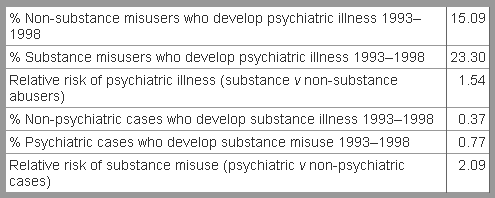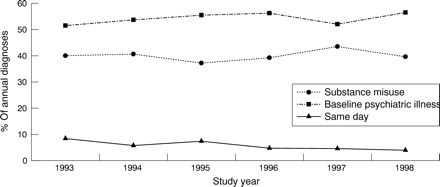The time-honored notion of reefer madness, given new life recently in the British tabloid press, has taken another hit from reality. Widespread marijuana use by the public has not been followed by a proportional rise in diagnoses of schizophrenia or psychosis, according to the findings of a forthcoming study to be published in the scientific journal Schizophrenia Research.
It stands to reason, after all: If marijuana really led to psychosis, wouldn't the streets be choked with burned-out, gibbering potheads?
Film director John Holowach, responsible for the documentary High: The True Tale of American Marijuana, wasn't surprised. "I've said it for years now," Holowach told SF Weekly. "If pot and mental illness were linked, the two should rise and fall with one another, but they don't."
Amidst a spate of breathless tabloid hysteria hyping the supposed dire threat from "Skunk," a potent pot strain, British lawmakers last year stiffened cannabis laws in the U.K. A team of researchers had fanned the flames in the July 28, 2007 issue of prestigious scientific journal The Lancet, proclaiming that smoking marijuana could boost one's risk of a "psychotic episode" by 40 percent or more.
In one fell swoop marijuana possession was reclassified from a verbal warning to a criminal offense punishable by up to five years in prison. British Prime Minister Gordon Brown, ex-Home Secretary Jacqui Smith, and others cited the supposed 'pot-schizophrenia link' as a major reason for the giant step backward.
For the new study, British investigators at Keele University Medical School compared trends in cannabis use and instances of schizophrenia in the United Kingdom from 1996 to 2005. The research showed that even as marijuana use soared among the general population, "incidence and prevalence of schizophrenia and psychoses were either stable or declining" during this period.
The authors concluded that an expected rise in diagnoses of schizophrenia and psychoses did not occur over the decade under study. "This study does not therefore support the ... link between cannabis use and incidence of psychotic disorders," the study concludes, adding "This concurs with other reports indicating that increases in population cannabis use have not been followed by increases in psychotic incidence."
The results of another clinical trial published earlier this month indicate that the recreational use of marijuana does not affect brain chemistry in a way that is consistent with the development of schizophrenia.
"Should we expect an apology -- or even better, a change in policy -- from the Gordon Brown regime any time soon? Or at the very least, will some sort of 'correction' be forthcoming from the mainstream news media?" asked Paul Armentano, deputy director of the National Organization for the Reform of Marijuana Laws (NORML). "I wouldn't hold my breath."
News Hawk- Ganjarden 420 MAGAZINE ® - Medical Marijuana Publication & Social Networking
Source: San Francisco Weekly
Author: Steve Elliott
Contact: San Francisco Weekly
Copyright: 2009 Village Voice Media
Website: After Further Review, Smoking Pot Doesn't Make You Crazy -- Blimey!
It stands to reason, after all: If marijuana really led to psychosis, wouldn't the streets be choked with burned-out, gibbering potheads?
Film director John Holowach, responsible for the documentary High: The True Tale of American Marijuana, wasn't surprised. "I've said it for years now," Holowach told SF Weekly. "If pot and mental illness were linked, the two should rise and fall with one another, but they don't."
Amidst a spate of breathless tabloid hysteria hyping the supposed dire threat from "Skunk," a potent pot strain, British lawmakers last year stiffened cannabis laws in the U.K. A team of researchers had fanned the flames in the July 28, 2007 issue of prestigious scientific journal The Lancet, proclaiming that smoking marijuana could boost one's risk of a "psychotic episode" by 40 percent or more.
In one fell swoop marijuana possession was reclassified from a verbal warning to a criminal offense punishable by up to five years in prison. British Prime Minister Gordon Brown, ex-Home Secretary Jacqui Smith, and others cited the supposed 'pot-schizophrenia link' as a major reason for the giant step backward.
For the new study, British investigators at Keele University Medical School compared trends in cannabis use and instances of schizophrenia in the United Kingdom from 1996 to 2005. The research showed that even as marijuana use soared among the general population, "incidence and prevalence of schizophrenia and psychoses were either stable or declining" during this period.
The authors concluded that an expected rise in diagnoses of schizophrenia and psychoses did not occur over the decade under study. "This study does not therefore support the ... link between cannabis use and incidence of psychotic disorders," the study concludes, adding "This concurs with other reports indicating that increases in population cannabis use have not been followed by increases in psychotic incidence."
The results of another clinical trial published earlier this month indicate that the recreational use of marijuana does not affect brain chemistry in a way that is consistent with the development of schizophrenia.
"Should we expect an apology -- or even better, a change in policy -- from the Gordon Brown regime any time soon? Or at the very least, will some sort of 'correction' be forthcoming from the mainstream news media?" asked Paul Armentano, deputy director of the National Organization for the Reform of Marijuana Laws (NORML). "I wouldn't hold my breath."
News Hawk- Ganjarden 420 MAGAZINE ® - Medical Marijuana Publication & Social Networking
Source: San Francisco Weekly
Author: Steve Elliott
Contact: San Francisco Weekly
Copyright: 2009 Village Voice Media
Website: After Further Review, Smoking Pot Doesn't Make You Crazy -- Blimey!






